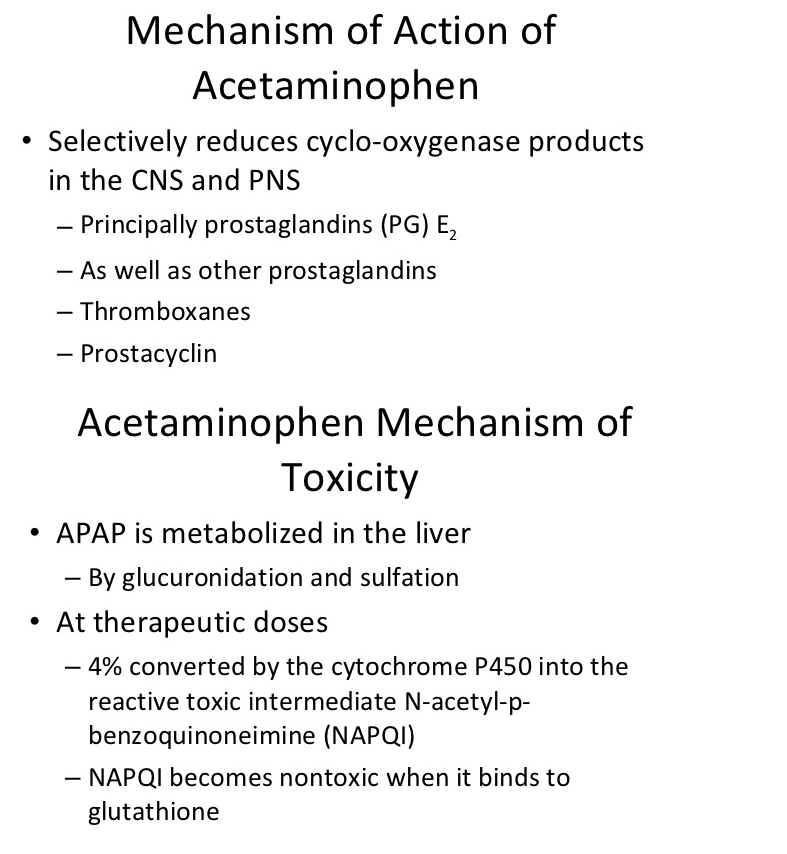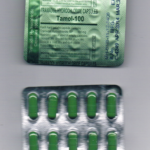Paracetamol (acetaminophen) is generally considered to be a weak inhibitor of the synthesis of prostaglandins (PGs). However, the in vivo effects of paracetamol are similar to those of the selective cyclooxygenase-2 (COX-2) inhibitors.

Paracetamol also decreases PG concentrations in vivo, but, unlike the selective COX-2 inhibitors, paracetamol does not suppress the inflammation of rheumatoid arthritis. It does, however, decrease swelling after oral surgery in humans and suppresses inflammation in rats and mice.

Paracetamol is a weak inhibitor of PG synthesis of COX-1 and COX-2 in broken cell systems, but, by contrast, therapeutic concentrations of paracetamol inhibit PG synthesis in intact cells in vitro when the levels of the substrate arachidonic acid are low (less than about 5 mumol/L). When the levels of arachidonic acid are low, PGs are synthesized largely by COX-2 in cells that contain both COX-1 and COX-2.
Thus, the apparent selectivity of paracetamol may be due to inhibition of COX-2-dependent pathways that are proceeding at low rates. This hypothesis is consistent with the similar pharmacological effects of paracetamol and the selective COX-2 inhibitors. COX-3, a splice variant of COX-1, has been suggested to be the site of action of paracetamol, but genomic and kinetic analysis indicates that this selective interaction is unlikely to be clinically relevant.
There is considerable evidence that the analgesic effect of paracetamol is central and is due to activation of descending serotonergic pathways, but its primary site of action may still be inhibition of PG synthesis. The action of paracetamol at a molecular level is unclear but could be related to the production of reactive metabolites by the peroxidase function of COX-2, which could deplete glutathione, a cofactor of enzymes such as PGE synthase.
Acetaminophen is thought to act primarily in the CNS, increasing the pain threshold by inhibiting both isoforms of cyclooxygenase, COX-1, COX-2, and COX-3 enzymes involved in prostaglandin (PG) synthesis. Unlike NSAIDs, acetaminophen does not inhibit cyclooxygenase in peripheral tissues and, thus, has no peripheral anti-inflammatory affects.
While aspirin acts as an irreversible inhibitor of COX and directly blocks the enzyme’s active site, studies have found that acetaminophen indirectly blocks COX, and that this blockade is ineffective in the presence of peroxides. This might explain why acetaminophen is effective in the central nervous system and in endothelial cells but not in platelets and immune cells which have high levels of peroxides. Studies also report data suggesting that acetaminophen selectively blocks a variant of the COX enzyme that is different from the known variants COX-1 and COX-2.
This enzyme is now referred to as COX-3. Its exact mechanism of action is still poorly understood, but future research may provide further insight into how it works. The antipyretic properties of acetaminophen are likely due to direct effects on the heat-regulating centres of the hypothalamus resulting in peripheral vasodilation, sweating and hence heat dissipation.
What are the uses for acetaminophen?
Acetaminophen is used for the relief of fever as well as aches and pains associated with many conditions. Acetaminophen relieves pain in mild arthritis but has no effect on the underlying inflammation, redness, and swelling of the joint. If the pain is not due to inflammation, acetaminophen is as effective as aspirin.
Acetaminophen is as effective as the non-steroidal anti-inflammatory drug ibuprofen (Motrin) in relieving the pain of osteoarthritis of the knee. Unless directed by a physician, acetaminophen should not be used for longer than 10 days.
Pain Medications, Pain Relief, and Pain Management









Good Article. Acetaminophen is thought to act primarily in the CNS, increasing the pain threshold by inhibiting both isoforms of cyclooxygenase, COX-1, COX-2, and COX-3 enzymes involved in prostaglandin (PG) synthesis. Unlike NSAIDs, acetaminophen does not inhibit cyclooxygenase in peripheral tissues and, thus, has no peripheral anti-inflammatory affects.